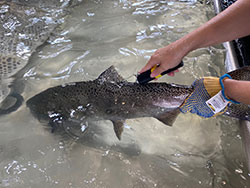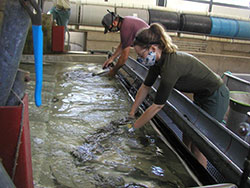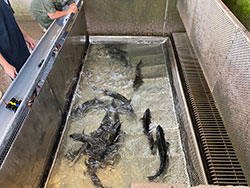Hallprint, spaghetti-style fish tags provide visual identification for Feather River Fish Hatchery staff that returning salmon are spring-run Chinooks that can be used for spawning and perpetuating the run of fish.

An early arrival to the Feather River Fish Hatchery receives a Hallprint, spaghetti style fish tag identifying it as a spring-run Chinook salmon before it is returned to the Feather River.

Feather River Fish Hatchery staff prepare spring-run Chinook salmon for tagging before these early arrivals are returned to the Feather River.

Spring-run Chinook salmon inside the Feather River Fish Hatchery.
The California Department of Fish and Wildlife’s Feather River Fish Hatchery in Butte County recently completed the tagging of 2,746 spring-run Chinook salmon in May and June.
The fish were early arrivals to the hatchery. After being outfitted with two external Hallprint, spaghetti-style fish tags on either side of their dorsal fin – two tags in case one comes out and is lost – the fish were returned to the Feather River. Unlike Passive Integrated Transponder (PIT) tags injected into many Chinook salmon smolts in order to monitor their movements, returns and hatcheries of origin, the external Hallprint tags are intended to provide visual identification to hatchery staff of returning spring-run Chinook salmon.
In September and October, the hatchery will spawn spring-run Chinook salmon, selecting among only those returning, externally tagged fish as broodstock in order to preserve the integrity of the spring-run fish and not mix genes with returning fall-run Chinook salmon. The ladder to the Feather River Fish Hatchery was closed July 1 to ensure only the early arriving spring-run Chinook salmon were tagged.
This process helps the hatchery achieve its goal of selecting and spawning salmon that represent the entire timeline of returning fish while keeping spring-run and fall-run salmon separated.
Feather River spring-run Chinook salmon are classified as threatened under both the state and federal endangered species acts. Tagging and spawning efforts help mitigate their decline. The goal is to ensure these native California fish can be enjoyed by generations to come.
CDFW Photos